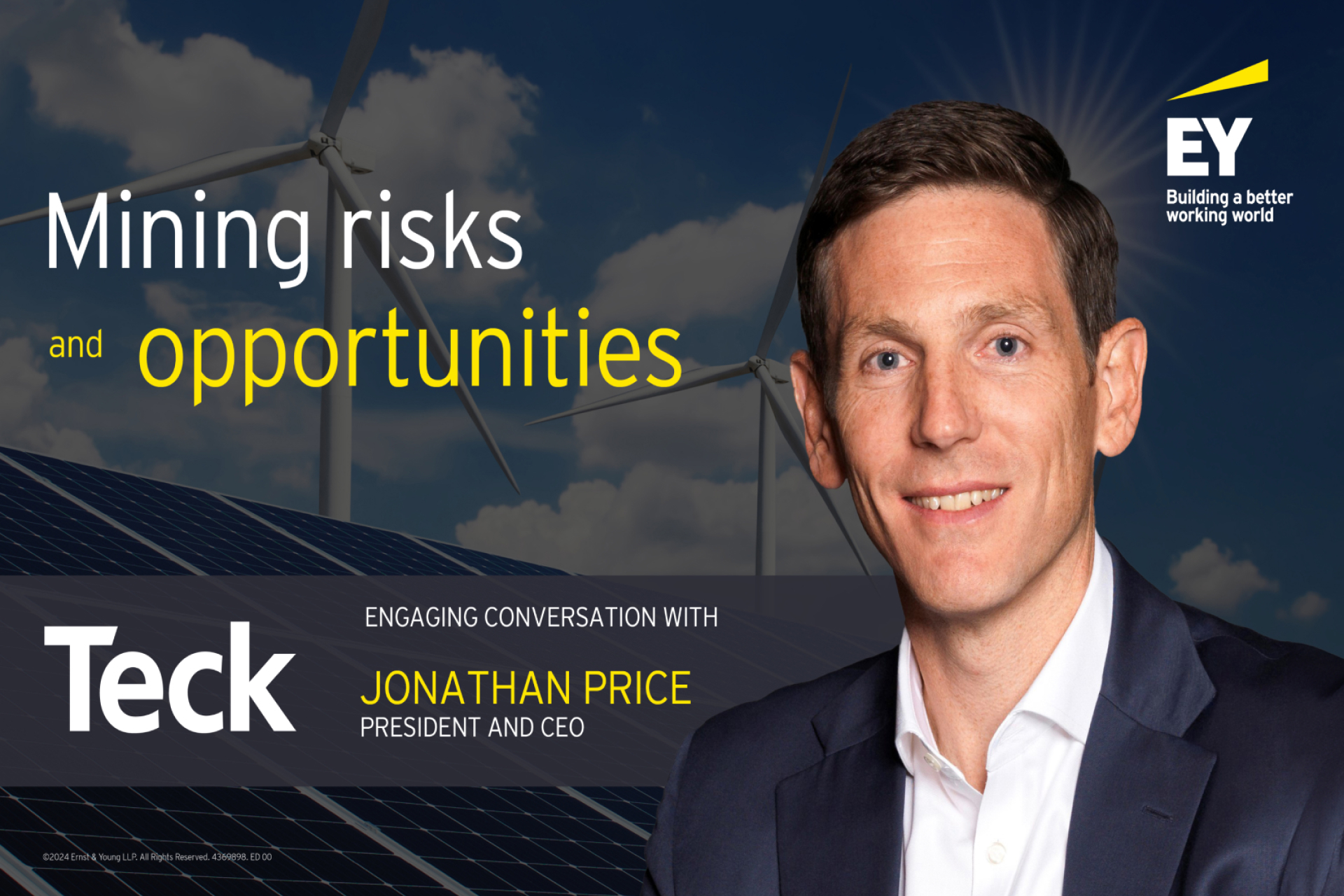EY refers to the global organization, and may refer to one or more, of the member firms of Ernst & Young Global Limited, each of which is a separate legal entity. Ernst & Young Global Limited, a UK company limited by guarantee, does not provide services to clients.
Insights
Asking the better questions that unlock new answers to the working world's most complex issue.
Services
EY helps clients create long-term value for all stakeholders. Enabled by data and technology, our services and solutions provide trust through assurance and help clients transform, grow and operate.
Industries
Discover how EY insights and services are helping to reframe the future of your industry.
See more
Case studies
Strategy and Transactions
How carve-outs positioned an automotive giant for future growth
12 Apr 2024EY Canada
About us
At EY, our purpose is building a better working world. The insights and services we provide help to create long-term value for clients, people and society, and to build trust in the capital markets.
See more
Top news
Recent Searches
Trending
-

Rethink customer experience as human experience
Technology is defining customer experience but differentiation comes from connecting to what is essentially human. Read more on studio.ey.com.
01 Jul 2024 Customer -

How can trust survive without integrity?
The EY Global Integrity Report 2024 reveals that rapid change and economic uncertainty make it harder for companies to act with integrity. Read our findings.
06 Jun 2024 -

Does today’s disruption provide the blueprint for tomorrow’s growth?
EY-Parthenon CEO Survey September 2025 reveals how leaders build confidence, resilience, and growth strategies amid disruption and transformation.
18 Sep 2025 CEO agenda
Mining today with EY – Episode 11:
Current valuation trends in mining and metals
Hear more from our industry advisors on valuation trends in mining and metals.
Featuring:
Jay Patel
Partner, EY Canada Mining & Metals Strategy and Transactions Leader
with:
Theo Yameogo
EY Americas Mining & Metals Leader, EY Canada Mining & Metals Leader
-
Theo Yameogo: Welcome Jay! You are our national leader in Mining & Metals for Strategy, Transactions and Valuations. And I look forward to our conversation today around the recent trends in the area.
Jay Patel: Thank you, Theo. Really excited to share insights with you today.
Theo Yameogo: Let's get right into it. Tell us about the recent trends you're seeing in your practice.
Jay Patel: Theo, right now things are really interesting. And I say so as you will obviously relate to the fact that economically we're seeing inflation, we're seeing higher costs, we're seeing supply chain challenges. And all these make for interesting considerations when we're looking at our clients' assets, which are all long-term assets. When you think about operating and development assets, we need to think about long-term impacts of these factors today.
And even on assets that are at an exploration stage, the option value of these assets does get impacted by these economic factors. So the work we're doing currently is really exciting, interesting and, of course intellectually curious as well.
We're very fortunate that we serve clients across the globe, and we serve clients who have assets that are operating or developing or in the exploration stage. So we see from start to finish these assets as they grow into operating assets. We also are fortunate that we see these assets across the world. So, really excited to be sharing insights based on the work we're doing today.
Theo Yameogo: That's very insightful, Jay. Economic aspects aside, what are the other takes on ESG when it comes to valuation nowadays?
Jay Patel: So ESG has a really positive impact on asset values, provided you're either working on ESG factors to increase cash flow or reduce risk. Because if you think about it, increasing cash flows, reducing risk, enhances asset value. And mining companies are doing great on this front, having started down the, what I would call ESG road much before ESG came into vogue.
ESG has been used since about 2003 as a term, whereas miners have talked about social licence to operate since about 1997. So they're a little bit ahead of the game as far as one can see. And what we're finding is miners have done a good job on all three aspects, the E, the S and the G.
On the environmental front, they've always looked at scarce resources and managed those well. Think about water as an example. On the social side, they've built schools, they've built hospitals in remote areas, and they've done this to essentially better engage employees.
And then on the governance end, they've actually helped local talent build up and manage their assets such that assets become sustainable. And all these efforts, they may seem like costly efforts, but they actually enhance cash flow by reducing volatility and enhancing asset values.
Theo Yameogo: Now, in practice, Jay, how are the efforts in ESG impacting asset values?
Jay Patel: I would say ESG impacts asset values in probably three different ways. One is you could actually be a miner owning metals that are needed for the energy transition. So really those assets become valuable in the current environment.
The second is if you've got production that is backed by a low-carbon footprint, think about hydro-generated electricity feeding your metal production, that metal actually becomes more valuable downstream to a consumer, and it enhances revenue, reduces your risk because you become embedded in a supply chain.
And the third aspect of ESG is really the initiatives that miners undertake to reduce the risk on their operations through ESG efforts, be it carbon reduction or be it providing health and educational facilities to their employees.
Theo Yameogo: Now let's take a macro view this time. So, in this current environment, what are clients looking for as advice?
Jay Patel: So we have a full-scale services where we provide advice either on an ad hoc basis to answer client questions or a full-scale service offering where EY teams provide valuation opinions, conclusions and so on.
At the moment, I would say we are working through the entire value chain, if you will, where we are providing advice on transactions, be it either board advisory, fairness opinions or public valuations, or on financial reporting and tax valuations. And in the current environment, where assets are in demand, especially low-carbon assets that are in demand, we are actually seeing enough transaction activity where clients are seeking advice either on the valuation front or pure strategy and transaction advice.
We also help clients with the complex instruments. So think about index-linked or gold price-linked or foreign exchange-linked instruments, be it debt or be it streaming transactions, for example. EY teams help clients with valuation of those assets as well.
And finally we help clients with financial and operating models, which are useful in transactions as well as operationally. And we're seeing demand across all these different areas that I mentioned as clients continue to expand and enhance their operations or continue to grow.
Theo Yameogo: Do you foresee that this is a super cycle where we're growing? I mean, you have a lot of experience in this space. Are we going to see, life of mine plans changing? What is your initial sense so far?
Jay Patel: I don't know that I like the term super cycle. I mean, I think we've been through ups and downs in the sector over time. So, rather than using the word super cycle, I think there are certainly certain assets that are really in demand.
And I think that's really driven by more macro environments where the world is definitely focused on low-carbon initiatives and reducing energy requirements, becoming more green. And so, I think there are certain assets, certain commodities that are going to remain more in the news, if you want to call it that. But I don't know that I would call it a super cycle.
The one thing I would say is miners continue to remain disciplined in their actions and you're not seeing transactions that the market would look at and question, “Why was that transaction done?” So I think we're in an environment where there's stability, if you will.
Theo Yameogo: Interesting. Now, Jay, in recent years, we've seen that some sector players are coming into the mining space. As somebody with tremendous experience in valuation with mining companies, what's your advice for these new entrants in the mining space?
Jay Patel: This is a really interesting question, Theo. I would say roughly 10 years ago, we were talking to an auto manufacturer out of Europe looking to buy a rare earth asset in North America. That did not happen, but today we are back in the same cycle where auto companies are realizing that they need reliable supply chains. And so there's certainly interest from auto companies into mining assets.
So I think mining companies that have metals that are relevant for energy transition will certainly see that sort of interest over time.
Theo Yameogo: So, should we anticipate more joint venture type business models?
Jay Patel: I think there's going to be more collaborative models, is my view, where both the miner and the non-miner, if you want to call it that, are looking to successfully develop an asset such that they're both collaborative with each other and, of course, earning decent returns.
The other thing I think you will find is sectors that want to transition away from high carbon will probably end up investing in mining as well. Think of, for example, oil and gas companies that would go down investing in lithium as an example.
Theo Yameogo: Yes, that's a good point. Now, Jay, what other leading practices can we glean from our clients?
Jay Patel: So I practice valuations. And the key benefit that I see when we work with clients that are well organized is they are collaborative, even internally. They will provide us with information from their technical department, their corporate development department, their finance department, their tax department, their senior management team.
And all that makes for robust input going into a valuation analysis and, hence, a better outcome and a better answer, if you will. Because valuation, at the end of the day, still remains as much art as science. So, considering many different perspectives just simply enhances the opinions, if you will.
Theo Yameogo: Now, Jay, if there's one thing that you want boards and senior management to have on their radar, on a regular basis, what would that be?
Jay Patel: I think to my mind, most boards and senior management teams do look at their asset values for financial reporting, as an example. I think that should get embedded as their corporate DNA to look at their entire portfolio once a year or so, so that you can enhance the value of the assets. You can understand which assets belong in your portfolio, which do not, such that you enhance the value of that asset portfolio.
Theo Yameogo: This has been a very insightful conversation, Jay. Thanks for being here.
Jay Patel: Theo, thank you so much for having me. I really enjoyed our conversation.
Strategy and Transactions
EY can help you manage the crisis and stabilize your business in the short-term. We can also help you navigate the downturn and position yourselves for the recovery or look beyond to enable your transformation through corporate strategy and transactions, M&A and divestments.
EY Americas Mining and Metals Centre of Excellence
The EY Americas Mining and Metals Centre of Excellence offers companies across North and South America access to cutting-edge services and innovation-led solutions to help meet the most pressing needs of mining and metals businesses today and in the future.
Related articles

BC tracks third highest expenditure in mineral exploration in a decade
Insights from the BC Mineral and Coal Exploration Survey 2023

Top mining risks and opportunities through the eyes of Teck's Jonathan Price
Jonathan Price discusses his vision for staying competitive and capitalizing on mining's top risks and opportunities such as ESG, digitalization, and productivity.

How Canada’s cleantech incentives will promote the critical minerals industry
Mining sector must seize the opportunity to unlock value from the booming critical minerals and electric vehicle/battery value chain in Canada.

Top 10 mining and metals risks in 2025
Significant transformation of the sector through innovation, collaboration and agility is critical for reshaping the future with confidence.